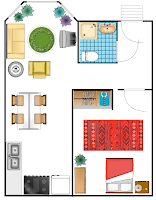 My first memories of graffiti as an artistic display originate from the mainstreaming of hip hop culture through theatrical vehicles such as 1984's Beat Street and Breakin'. Graffiti, along with amazing break dancing moves and upbeat characters, seemed to brighten up the urban decay both films displayed as symptoms of a society unsympathetic to the needs of urban adolescents looking for a way out of their less than ideal situations. The graffiti painted on buildings, trains and just about everything else seemed to transcend the more rigid world of art I was taught to appreciate. My appreciation for graffiti and the nuances of the art form continued to grow with seminal documentaries such as PBS's Style Wars, a fascinating study of graffiti artists in New York. My love of graffiti was further fostered by the area I live in. In Atlanta we have some amazing graffiti on display, most notably in the Krog street tunnel located in Grant Park (pictured above).
My first memories of graffiti as an artistic display originate from the mainstreaming of hip hop culture through theatrical vehicles such as 1984's Beat Street and Breakin'. Graffiti, along with amazing break dancing moves and upbeat characters, seemed to brighten up the urban decay both films displayed as symptoms of a society unsympathetic to the needs of urban adolescents looking for a way out of their less than ideal situations. The graffiti painted on buildings, trains and just about everything else seemed to transcend the more rigid world of art I was taught to appreciate. My appreciation for graffiti and the nuances of the art form continued to grow with seminal documentaries such as PBS's Style Wars, a fascinating study of graffiti artists in New York. My love of graffiti was further fostered by the area I live in. In Atlanta we have some amazing graffiti on display, most notably in the Krog street tunnel located in Grant Park (pictured above).In the last few years a number of books have appeared to document and celebrate graffiti culture, both in the United States and abroad. Any library wishing to serve the interests and needs of all patrons would be remiss in forgoing books dealing with graffiti art due to negative connotations ascribed to the form. Many people still view graffiti as a visual blight, a contention I would sometimes have to agree with given the lack of creativity displayed by some taggers. However, the continued outsider status of graffiti art allows it to stay fresh, interesting and viable.
Below I have listed graffiti books in the CFL collection and some websites I enjoy.
The Birth of Graffiti / Jon Naar
080 NAAR
Graffiti Paris / Photographs by Fabienne Grévy.
751.7 GREVY
Graphic Design: A New History / Stephen J. Eskilson
760 ESKIL
Piecebook: The Secret Drawings of Graffiti Writers / Sacha Jenkins
751.7 JENK
Postmodern Perspectives: Issues In Contemporary Art
709.04 POST
Art Crimes: The Writing On The Wall
The largest online collection of worldwide graffiti photos
Graffiti Maker
Create your own graffiti on your computer
Banksy
An amazing British graffiti artist!!!
Flickr
Collection of photos on Flickr tagged as "graffiti"
- Krog street tunnel photo courtesy of Glenn Lewis Images.
- Christopher Bishop


